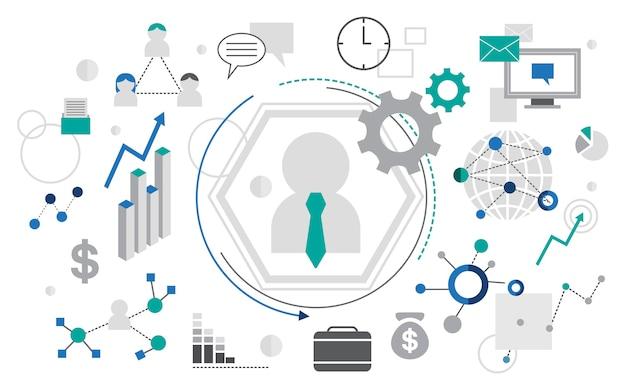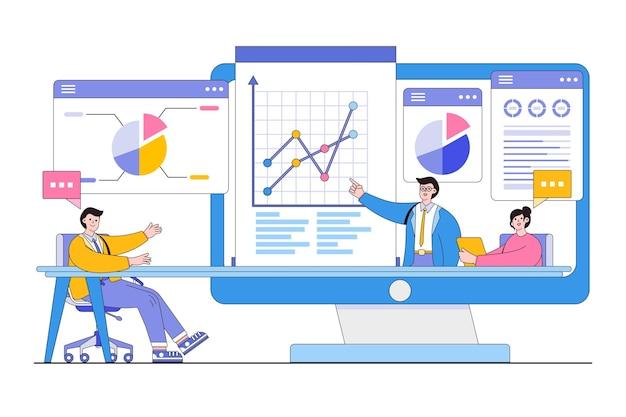Have you ever wondered how the products you love end up in your hands? Behind every product, there is a complex web of activities, processes, and people that make it happen. This is what we call the supply chain. And like many other industries, the supply chain is constantly evolving, driven by technology and innovation. One of the most significant changes in recent years has been the increasing use of data analytics.
Value chain data analytics can provide valuable insights that can help businesses optimize their operations, reduce costs, and improve customer satisfaction. Supply chain analytics examples include predicting demand, optimizing inventory, and improving logistics, among others. These analytics require a particular set of skills, which has led to the emergence of supply chain advanced analytics jobs.
So, what is advanced analytics in supply chain? It refers to the use of advanced statistical and predictive modeling techniques to extract insights from supply chain data. By analyzing historical data and identifying patterns, businesses can make better decisions, reduce risk, and gain a competitive advantage. There are five common types of supply chain analytics which include descriptive, diagnostic, predictive, prescriptive, and cognitive analytics.
In this blog post, we’ll delve into the world of supply chain advanced analytics. We’ll explore how businesses are using data to optimize their supply chain operations, the different types of analytics, and the skill set required for supply chain advanced analytics jobs. So, buckle up, as we take you on a journey through the exciting and ever-evolving world of supply chain advanced analytics!
Supply Chain Advanced Analytics: Leveraging Data for Optimal Efficiency
Supply chain management can be a challenging and complex process, particularly when faced with volatile market conditions. However, with the advent of advanced analytics, organizations can now leverage data to improve their supply chain operations significantly.
Streamlined Planning and Forecasting
Advanced analytics can allow organizations to examine historical data and use predictive modeling to improve demand planning and forecasting. This helps organizations to better anticipate market trends and changes in consumer demand, allowing them to adjust their supply chain operations accordingly. With more accurate forecasts, organizations can optimize their inventory levels, reducing stockouts and overstocking, ultimately improving their bottom line.
Improved Efficiency
By utilizing advanced analytics tools to track and monitor supply chain operations at real-time, you can significantly boost efficiency. For instance, predictive analytics can help identify bottlenecks or potential disruptions in supply chains, allowing companies to address these issues proactively. This not only helps to avoid delays and disruptions but can also save time and costs associated with unscheduled maintenance or repairs.
Enhanced Visibility
Increased visibility into your supply chain operations is critical for decision-making. Advanced analytics tools allow companies to capture and analyze data from various sources, providing visibility into supplier performance and inventory levels. With such transparency, companies can make informed decisions, and identify areas where improvement is needed, ultimately improving overall supply chain performance.
Identifying Cost Savings Opportunities
With advanced analytics tools, you can identify and prioritize cost-saving opportunities across your supply chain operations. Advanced analytics can help to identify cost savings in various areas, including transportation, procurement, production, and inventory. By identifying cost-saving opportunities across the supply chain, organizations can minimize expenses, improve efficiency, and remain competitive in today’s market.
In conclusion, organizations that want to optimize their supply chain processes to improve efficiency, enhance visibility, and identify cost-saving opportunities can leverage advanced analytics tools. With the right analytics, supply chain operations are streamlined, potential disruptions are identified and addressed, and overall performance is improved.
Value Chain Data Analytics
In today’s world, data is the new oil, and nowhere is this truer than in the field of supply chain management. Value chain data analytics refers to the practice of analyzing the data generated by the various stages of the value chain to gain insights into business performance and identify areas where improvements can be made.
What is Value Chain Data Analytics
The value chain is the series of steps involved in creating a product or service, from the raw materials used to the final product delivered to customers. Each of these steps generates large amounts of data, and value chain data analytics involves collecting, processing, and analyzing this data to gain insights into business performance.
Benefits of Value Chain Data Analytics
Value chain data analytics can provide significant benefits to supply chain operations, including:
- Improved efficiency: By analyzing data throughout the value chain, businesses can identify bottlenecks, inefficiencies, and areas where improvements can be made.
- Better decision-making: By having access to accurate data, decision-makers can make more informed choices that lead to better outcomes.
- Increased profitability: By optimizing operations and making smarter decisions, businesses can improve their profitability and gain a competitive advantage.
Tools and Techniques
There are a variety of tools and techniques used in value chain data analytics, including:
- Descriptive analytics: This involves analyzing historical data to understand what has happened in the past and gain insights into trends and patterns.
- Predictive analytics: This involves using statistical models to predict future outcomes based on historical data.
- Prescriptive analytics: This involves using optimization algorithms to identify the best course of action for a given situation.
Challenges
While value chain data analytics can offer significant benefits, there are also challenges to implementing these practices. Some of the challenges include:
- Data quality: To gain accurate insights, businesses need to ensure that the data they are collecting is accurate and consistent.
- Data integration: With data coming from multiple sources, it can be challenging to ensure that it is all integrated correctly and can be analyzed effectively.
- Data privacy: With concerns about data privacy and security, businesses need to be careful about how they collect, store, and use data.
Value chain data analytics represents a significant opportunity for businesses looking to improve their supply chain operations. By taking advantage of the vast amounts of data generated by the value chain, businesses can optimize their operations, make more informed decisions, and gain a competitive advantage in their industry.
Supply Chain Analytics Examples
Have you ever wondered how supply chain analytics can be applied in practical scenarios? Let’s explore some examples of how businesses have leveraged the power of supply chain analytics to streamline their operations and enhance their bottom line.
Inventory Management
One of the most common uses of supply chain analytics is inventory management. With real-time data analysis, businesses can track their inventory levels accurately and make data-driven decisions about when to order more supplies or reduce their stock levels. By optimizing their inventory levels, businesses can reduce waste, minimize risk, and improve their overall efficiency.
Supplier Performance
Another vital area where supply chain analytics can make a significant impact is supplier performance. By tracking supplier data, such as delivery time, quality, and cost, businesses can identify which suppliers are meeting their expectations and which ones are falling short. With this knowledge, businesses can renegotiate contracts, find alternative suppliers if necessary, and ultimately improve their supply chain’s overall performance.
Transportation Optimization
Transportation optimization is another area where supply chain analytics can be applied. By analyzing transportation data, businesses can optimize their shipping routes, consolidate shipments, and select the most cost-effective carriers. By doing so, businesses can reduce their transportation costs, improve delivery times, and enhance customer satisfaction.
Demand Forecasting
Supply chain analytics can also be used for demand forecasting, a critical component of supply chain management. By analyzing historical sales data and market trends, businesses can predict future demand for their products and adjust their production schedules accordingly. This helps businesses avoid stockouts, reduce excess inventory, and ultimately improve their overall profitability.
In conclusion, supply chain analytics is a powerful tool that can help businesses optimize their operations, reduce costs, and enhance their bottom line. By leveraging the power of data analysis, businesses can make informed decisions about inventory management, supplier performance, transportation optimization, and demand forecasting. Are there any other examples of supply chain analytics you find interesting or have experience with? Let us know in the comments below!
Supply Chain Advanced Analytics Jobs
Many businesses today are rapidly adopting supply chain advanced analytics to optimize their processes and increase efficiency. With this development comes a demand for professionals skilled in the field of supply chain analytics.
What Are Supply Chain Advanced Analytics Jobs
Supply chain advanced analytics jobs refer to roles in which individuals use different technologies to collect, analyze, and interpret supply chain data to make informed business decisions. Individuals in these roles form critical parts of business teams who are responsible for delivering data insights, identifying trends, providing recommendations for improvement, and collaborating with cross-functional teams to implement action plans.
What Skills Do You Need for A Supply Chain Advanced Analytics Job
To land a supply chain analytics job, you need some valuable technical and soft skills. Many employers look for candidates with a strong mathematical background and experience using various analytics software and tools like SQL, SAS, R, Python, and Excel. Additionally, you should possess strong analytical skills, attention to detail, problem-solving abilities, and a creative mindset.
What Roles Can You Work in Supply Chain Advanced Analytics
Several roles are available in the realm of supply chain advanced analytics. These roles include:
- Supply Chain Data Analyst
- Supply Chain Analytics Manager
- Logistics Analytics Specialist
- Procurement Analytics Consultant
In each of these roles, you are required to utilize your skills in supply chain analysis to collect, process, and interpret data while providing insights that can be used to improve the supply chain process.
Supply chain advanced analytics jobs are growing increasingly vital in the age of technology and big data. Possession of relevant technical and soft skills such as data analysis, problem-solving, and communication, makes candidates eligible for roles in this field. With a supply chain analytics job, you can make an impact in your organization and start a fulfilling career.
What is Advanced Analytics in Supply Chain
In simple terms, advanced analytics refers to the use of complex mathematical algorithms and statistical models to analyze large sets of data in order to identify trends, patterns, and insights. When it comes to the supply chain, advanced analytics can help organizations gain a deeper understanding of their operations and make data-driven decisions to improve efficiency, reduce costs, and increase profitability.
Why is Advanced Analytics Important for Supply Chain Management
Supply chain management is a complex and dynamic process that involves multiple stakeholders, including manufacturers, distributors, retailers, and customers. In order to optimize the supply chain, organizations need to have a clear understanding of what’s happening at each stage of the process. This is where advanced analytics can really make a difference.
By leveraging the power of advanced analytics, supply chain managers can gain real-time visibility into their operations and identify areas of inefficiency or waste. For example, they can use predictive analytics to forecast demand and optimize inventory levels, or use network optimization algorithms to identify the most efficient transportation routes.
Types of Advanced Analytics Used in Supply Chain Management
There are several different types of advanced analytics that are commonly used in supply chain management, including:
-
Predictive Analytics – This involves using historical data to identify patterns and make predictions about future outcomes.
-
Prescriptive Analytics – This takes predictive analytics a step further by providing recommendations on how to improve performance or mitigate risk.
-
Network Optimization – This involves identifying the most efficient distribution network based on factors such as cost, speed, and reliability.
-
Simulation – This allows supply chain managers to test various scenarios in a virtual environment before implementing them in the real world.
Advanced analytics is becoming increasingly important in supply chain management as organizations look for ways to optimize their operations and gain a competitive advantage. By using advanced analytics tools and techniques, supply chain managers can gain deeper insights into their operations and make data-driven decisions to improve efficiency, reduce costs, and increase profitability.
5 Common Types of Supply Chain Analytics
When it comes to supply chain analytics, there are different types that can be utilized depending on the needs and goals of a particular business. Here are the five most common types of supply chain analytics used by businesses today:
Descriptive Analytics
Descriptive analytics is used to summarize and provide insight into past events. This type of analytics typically involves data mining and aggregation to provide valuable insight into how a supply chain performed in the past. Descriptive analytics is useful for determining patterns and trends and is often used to optimize supply chain processes.
Predictive Analytics
Predictive analytics uses relevant data to forecast future trends and events. With this type of analytics, businesses can make proactive decisions based on predictions to prevent potential supply chain bottlenecks, disruptions, or failures. Predictive analytics enables businesses to make informed decisions and mitigate risks through informed forecasting.
Diagnostic Analytics
Diagnostic analytics focuses on identifying the cause and effect of specific events within the supply chain. It involves analyzing operational performance metrics to determine the root cause of problems or inefficiencies and helps businesses to optimize and improve upon them.
Prescriptive Analytics
Prescriptive analytics, sometimes referred to as optimization analytics, is used to identify the best course of action based on the current data. It analyzes various scenarios and determines the most optimal path to take to improve supply chain performance. Prescriptive analytics is becoming increasingly essential in the digitization and automation of the supply chain.
Cognitive Analytics
Cognitive analytics is an advanced type of supply chain analytics that uses artificial intelligence (AI) and machine learning (ML) to predict, diagnose, and prescribe actions. It can learn and adapt to new data patterns and make recommendations for improvements in real-time based on analysis.
Overall, these five types of supply chain analytics are essential tools that can help businesses make more informed decisions and optimize their supply chain processes. By employing these analytics, businesses can gain critical insight into their supply chain operations, quickly adapt to changing conditions, and stay ahead of the competition.



